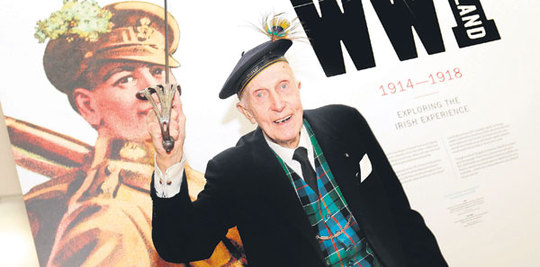A 98-year-old Sir Jack Leslie (above) brandishes his uncle Norman’s sword that was used to attack a German machine gun position in October 1914.
Norman Leslie, second son of the Leslie family from Castle Leslie in Co Monaghan, became heir to the family estate when his elder brother, Shane, converted to Catholicism and became a supporter of Irish Home Rule.
An experienced soldier when the First World War broke out, Norman was shot and killed while charging the German machine gun armed only with the sword, as it was considered ungentlemanly for officers to carry guns.
The sword he was carrying when he died was eventually returned to the Leslie family, and now hangs in the gallery of Castle Leslie.
The sword features among numerous other items relating to the war and the Irish experience at an exciting new exhibition at the National Library of Ireland.
Sir Jack was accompanied by his nephew, Mark Leslie, and Mark’s son, Luke, and descendants of Mary Martin, whose wartime diary is also included in the exhibition, at the launch that was also attended by the British Ambassador to Ireland, Dominick Chilcott.
The Minister for Arts, Heritage and the Gaeltacht, Heather Humphreys officially launched the exhibition which recalls the wartime experiences of the Leslies of Castle Leslie in Co Monaghan, and the Plunketts of Dublin, two of Ireland’s best-known families.
Joseph Mary Plunkett, the poet, journalist and revolutionary, is best known as a leader of the 1916 Rising and a signatory of the Proclamation of the Irish Republic.
In April 1915, he accompanied Roger Casement to Germany to seek German support for an uprising in Ireland. He subsequently fought alongside Pearse and Connolly in the GPO in 1916. Imprisoned in Kilmainham Gaol, he married Grace Gifford just hours before his execution in May 1916.
Also featured is the story of Mary Martin, a widow and mother of 12 from Monkstown.
Three of her children served overseas during the war, including her son, Charlie, who was reported wounded and missing in late 1915.
Believing he had been taken prisoner, Mary began keeping a diary in the form of a letter to Charlie. She subsequently discovered he had died of his wounds soon after his capture.
Her other children, including her daughter Marie, survived the war. Marie, who had served as a nurse in Malta and France, went on to found the Medical Missionaries of Mary in 1937. Mary’s wartime diary is included in the NLI exhibition.
Another tale told is that of Michael O’Leary, a farmer’s son from Co Cork, who served with the Irish Guards on the Western Front.
In February 1915, he single-handedly charged two German barricades in France, killing eight men and taking two prisoner. He was awarded the Victoria Cross, and became internationally famous, with journalists even thronging to the O’Leary family farm in Cork.
The story of his wartime exploits was put to very different uses, inspiring both a recruiting campaign and a satirical play by George Bernard Shaw. He retired from the army in 1921, but re-joined during World War Two. He died in 1961.
Their stories are highlighted in the exhibition, World War Ireland: Exploring the Irish Experience, at the National Library of Ireland (NLI).
The new exhibition features letters, diaries, newspapers, photographs, leaflets and posters from the NLI’s collections.
Speaking ahead of the launch, Nikki Ralston, exhibition curator for the NLI, said:
“Irish people had very diverse and complex reactions to World War I. This exhibition captures those sentiments, and also recounts the tense domestic situation in the Ireland of 1914.
?
